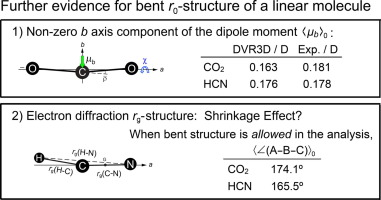当前位置:
X-MOL 学术
›
J. Mol. Spectrosc.
›
论文详情
Our official English website, www.x-mol.net, welcomes your feedback! (Note: you will need to create a separate account there.)
More evidence for bent ro-vibrationally averaged structures of linear triatomic molecules: The non-zero b axis component of the dipole moment and the rg structure in electron diffraction
Journal of Molecular Spectroscopy ( IF 1.4 ) Pub Date : 2020-03-01 , DOI: 10.1016/j.jms.2020.111252 Tsuneo Hirano , Umpei Nagashima , Masaaki Baba
Journal of Molecular Spectroscopy ( IF 1.4 ) Pub Date : 2020-03-01 , DOI: 10.1016/j.jms.2020.111252 Tsuneo Hirano , Umpei Nagashima , Masaaki Baba

|
Abstract We have previously demonstrated theoretically, by computing expectation values over the bending wavefunction, and experimentally, by re-interpreting observed values of the rotational constant B 0 , that a linear triatomic molecule will necessarily be observed as being bent on ro-vibrational average. We present here further evidence for this assertion: (1) the non-zero b axis component of the electric dipole moment 〈 μ b 〉 for the linear molecules CO2, HCN, and HCO+, and (2) the internuclear distances r g in electron diffraction (ED) for CO2 and HCN when re-interpreted without an a priori assumption of the linear ro-vibrationally-averaged structure. In either case, the theoretical values calculated as the expectation values over the DVR3D wavefunctions show good agreement with the corresponding experimental values. If, as in a conventional paradigm, the r 0 structure of a linear molecule were observed as linear, the 〈 μ b 〉 would be of zero-value and the shrinkage effects in ED (claimed in the 1960s for the observation that the distance between terminal atoms was shorter than the sum of the constituent bond lengths) would become inevitable. Hence, the non-zero value of 〈 μ b 〉 and no shrinkage effect in the reasonable, re-interpreted terminal-atom distance in ED, definitely show the bent ro-vibrationally averaged structure on observation even for the ro-vibrational ground state. Thus, we have additional pieces of indisputable evidence supporting the assertion that the ro-vibrationally averaged structure of a linear molecule is “bent” on observation.
中文翻译:

线性三原子分子弯曲 ro-vibrationally 平均结构的更多证据:偶极矩的非零 b 轴分量和电子衍射中的 rg 结构
摘要 我们之前已经在理论上证明,通过计算弯曲波函数的期望值,并在实验上,通过重新解释旋转常数 B 0 的观测值,线性三原子分子将必然被观察为在旋转振动平均值上弯曲。我们在此为这一断言提供进一步的证据:(1) 线性分子 CO2、HCN 和 HCO+ 的电偶极矩 < μ b > 的非零 b 轴分量,以及 (2) 电子衍射中的核间距离 rg (ED) 在没有先验假设线性旋转振动平均结构的情况下重新解释 CO2 和 HCN。在任何一种情况下,作为 DVR3D 波函数的期望值计算的理论值与相应的实验值非常吻合。如果,在传统范式中,线性分子的 r 0 结构被观察为线性,< μ b > 将为零值和 ED 中的收缩效应(在 1960 年代声称观察到末端原子之间的距离短于组成键长度的总和)将变得不可避免。因此,<μb> 的非零值和 ED 中合理的、重新解释的末端原子距离中没有收缩效应,即使对于旋转振动基态,也确实显示了观察时弯曲的旋转振动平均结构。因此,我们有额外的无可争辩的证据支持线性分子的旋转振动平均结构在观察中“弯曲”的断言。< μ b > 将为零值,ED 中的收缩效应(在 1960 年代因观察到末端原子之间的距离短于组成键长的总和而声称)将变得不可避免。因此,<μb> 的非零值和 ED 中合理的、重新解释的末端原子距离中没有收缩效应,即使对于旋转振动基态,也确实显示了观察时弯曲的旋转振动平均结构。因此,我们有额外的无可争辩的证据支持线性分子的旋转振动平均结构在观察中“弯曲”的断言。< μ b > 将为零值,ED 中的收缩效应(在 1960 年代因观察到末端原子之间的距离短于组成键长的总和而声称)将变得不可避免。因此,<μb> 的非零值和 ED 中合理的、重新解释的末端原子距离中没有收缩效应,即使对于旋转振动基态,也确实显示了观察时弯曲的旋转振动平均结构。因此,我们有额外的无可争辩的证据支持线性分子的旋转振动平均结构在观察中“弯曲”的断言。〈 μ b 〉的非零值和在 ED 中合理的、重新解释的末端原子距离中没有收缩效应,即使对于 ro-vibrational 基态,也确实显示了观察时弯曲的 ro-vibrationally 平均结构。因此,我们有额外的无可争辩的证据支持线性分子的旋转振动平均结构在观察中“弯曲”的断言。〈 μ b 〉的非零值和在 ED 中合理的、重新解释的末端原子距离中没有收缩效应,即使对于 ro-vibrational 基态,也确实显示了观察时弯曲的 ro-vibrationally 平均结构。因此,我们有额外的无可争辩的证据支持线性分子的旋转振动平均结构在观察中“弯曲”的断言。
更新日期:2020-03-01
中文翻译:

线性三原子分子弯曲 ro-vibrationally 平均结构的更多证据:偶极矩的非零 b 轴分量和电子衍射中的 rg 结构
摘要 我们之前已经在理论上证明,通过计算弯曲波函数的期望值,并在实验上,通过重新解释旋转常数 B 0 的观测值,线性三原子分子将必然被观察为在旋转振动平均值上弯曲。我们在此为这一断言提供进一步的证据:(1) 线性分子 CO2、HCN 和 HCO+ 的电偶极矩 < μ b > 的非零 b 轴分量,以及 (2) 电子衍射中的核间距离 rg (ED) 在没有先验假设线性旋转振动平均结构的情况下重新解释 CO2 和 HCN。在任何一种情况下,作为 DVR3D 波函数的期望值计算的理论值与相应的实验值非常吻合。如果,在传统范式中,线性分子的 r 0 结构被观察为线性,< μ b > 将为零值和 ED 中的收缩效应(在 1960 年代声称观察到末端原子之间的距离短于组成键长度的总和)将变得不可避免。因此,<μb> 的非零值和 ED 中合理的、重新解释的末端原子距离中没有收缩效应,即使对于旋转振动基态,也确实显示了观察时弯曲的旋转振动平均结构。因此,我们有额外的无可争辩的证据支持线性分子的旋转振动平均结构在观察中“弯曲”的断言。< μ b > 将为零值,ED 中的收缩效应(在 1960 年代因观察到末端原子之间的距离短于组成键长的总和而声称)将变得不可避免。因此,<μb> 的非零值和 ED 中合理的、重新解释的末端原子距离中没有收缩效应,即使对于旋转振动基态,也确实显示了观察时弯曲的旋转振动平均结构。因此,我们有额外的无可争辩的证据支持线性分子的旋转振动平均结构在观察中“弯曲”的断言。< μ b > 将为零值,ED 中的收缩效应(在 1960 年代因观察到末端原子之间的距离短于组成键长的总和而声称)将变得不可避免。因此,<μb> 的非零值和 ED 中合理的、重新解释的末端原子距离中没有收缩效应,即使对于旋转振动基态,也确实显示了观察时弯曲的旋转振动平均结构。因此,我们有额外的无可争辩的证据支持线性分子的旋转振动平均结构在观察中“弯曲”的断言。〈 μ b 〉的非零值和在 ED 中合理的、重新解释的末端原子距离中没有收缩效应,即使对于 ro-vibrational 基态,也确实显示了观察时弯曲的 ro-vibrationally 平均结构。因此,我们有额外的无可争辩的证据支持线性分子的旋转振动平均结构在观察中“弯曲”的断言。〈 μ b 〉的非零值和在 ED 中合理的、重新解释的末端原子距离中没有收缩效应,即使对于 ro-vibrational 基态,也确实显示了观察时弯曲的 ro-vibrationally 平均结构。因此,我们有额外的无可争辩的证据支持线性分子的旋转振动平均结构在观察中“弯曲”的断言。


























 京公网安备 11010802027423号
京公网安备 11010802027423号